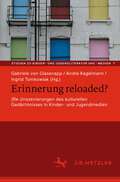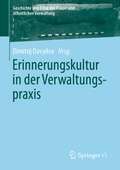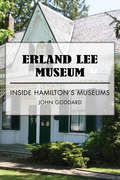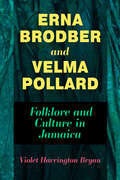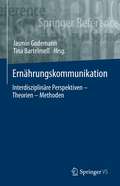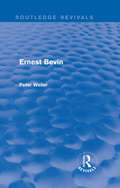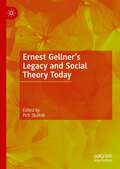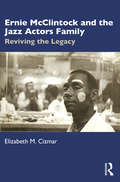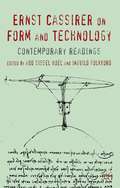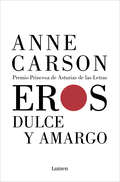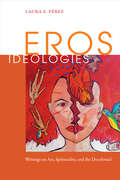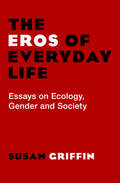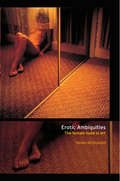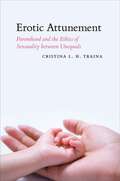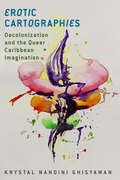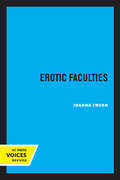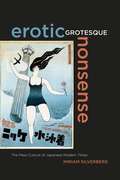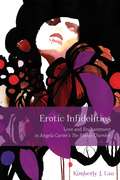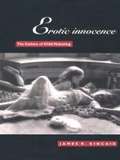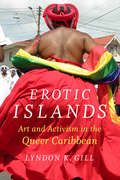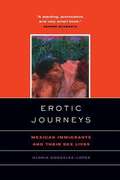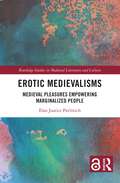- Table View
- List View
Erinnerung reloaded?: (Re-)Inszenierungen des kulturellen Gedächtnisses in Kinder- und Jugendmedien (Studien zu Kinder- und Jugendliteratur und -medien #7)
by Ingrid Tomkowiak Gabriele Von Glasenapp Andre KagelmannDer Band lotet die Bedingungen des Erinnerns und Erzählens und damit einer Re-Inszenierung der Vergangenheit im Feld der Kinder- und Jugendmedien aus. Besonderes Augenmerk wurde auf das Spannungsfeld von ‚objektiver‘ Geschichtswissenschaft einerseits und Dichtung andererseits gelegt, angesiedelt zwischen den Polen Referenzialität und einem neuen Interesse am vermeintlich Authentischen sowie der Fiktionalisierung von Fakten. Dieser Widerspruch ist von besonderer Bedeutung für die geschichtserzählenden Kinder- und Jugendmedien mit ihrem spezifischen Funktionsrahmen von ästhetischer und pädagogischer Horizontbildung und -erweiterung. Neben den traditionellen kinder- und jugendliterarischen Erinnerungsmedien – erzählende Literatur, historische und zeitgeschichtliche Romane, (autofiktionale) Biographien – sowie Drama und Lyrik werden Bilderbücher, Comics, Filme, Serien und Computerspiele in den Blick genommen.
Erinnerungskultur in der Verwaltungspraxis (Geschichte und Ethik der Polizei und öffentlichen Verwaltung)
by Dimitrij DavydovDie Aufrechterhaltung der Erinnerung an die Opfer von Krieg und Gewaltherrschaft, an Widerstand, Flucht und Vertreibung wird heute überwiegend als eine gesamtgesellschaftliche Aufgabe wahrgenommen und nicht als eine alleinige Prärogative des Staates. Dennoch ist öffentliches Erinnern und Gedenken als Bestandteil des kulturstaatlichen Auftrags von Bund, Ländern und Kommunen anerkannt. Der Umgang des Staates und seiner Institutionen mit (schmerzhafter) Vergangenheit und den Orten, an denen die Erinnerung an diese Vergangenheit „haftet“, ist zwar seit Jahren Gegenstand intensiver Forschung. Die verwaltungsrechtliche und verwaltungshistorische Perspektive ist dabei jedoch deutlich unterrepräsentiert gewesen. Nicht nur Fragen der Aufgabenverteilung zwischen den staatlichen und den zivilgesellschaftlichen Akteuren, sondern auch die Kompetenzen, Organisationsformen und Entscheidungsmaßstäbe der mit Erinnerungsaufgaben befassten Behörden und Einrichtungen sind bislang nur punktuell beleuchtet worden. Sind der Bund und die Länder allein als Förderer oder Koordinatoren für kommunale und zivilgesellschaftliche erinnerungskulturelle Aktivitäten gefragt? Besteht ein Handlungsbedarf für die Schaffung einer zentralen – zumindest einer überörtlichen – erinnerungskulturellen Infrastruktur? Bedürfen Gedenkstätten und andere Erinnerungsorte eines spezifischen ordnungsrechtlichen Schutzes? Wie kann die Sicherstellung des Pietätsschutzes an Orten des Gedenkens verfassungskonform ausgestaltet werden? Erfordert ein angemessener Umgang mit flächenhaften Zeugnissen der deutschen Vergangenheit wie dem Westwall und den Relikten des „Eisernen Vorhangs“ besondere rechtliche Vorkehrungen?Diese Lücke soll der vorliegende Band füllen, der im Rahmen eines von der Hochschule für Polizei und öffentliche Verwaltung des Landes Nordrhein-Westfalen geförderten Projekts entstanden ist. Autor:innen des Bandes sind Jurist:innen und Historiker:innen aus den Bereichen Lehre, Forschung und Verwaltung.
Erland Lee Museum: Inside Hamilton's Museums
by John GoddardInside Hamilton’s Museums helps to satisfy a growing curiosity about Canada’s steel capital as it evolves into a post-industrial city and cultural destination. In this special excerpt we visit Erland Lee Museum, which stands as an excellent example of Ontario Gothic Revival architecture and serves as the birthplace of the Women's Institute movement. John Goddard takes us on a detailed tour of the historic home, providing fascinating historical background and insight.
Erna Brodber and Velma Pollard: Folklore and Culture in Jamaica (Caribbean Studies Series)
by Violet Harrington BryanErna Brodber and Velma Pollard, two sister-writers born and raised in Jamaica, re-create imagined and lived homelands in their literature by commemorating the history, culture, and religion of the Caribbean. Velma Pollard was born in St. Catherine, Jamaica. By the time she was three, her parents had moved to Woodside, St. Mary, in northeast Jamaica, where her sister, Erna, was born. Even though they both travel widely and often, the sisters both still live in Jamaica. The sisters write about their homeland as a series of memories and stories in their many works of fiction, nonfiction, and poetry. They center on their home village of Woodside in St. Mary Parish, Jamaica, occasionally moving the settings of their fiction and poetry to other regions of Jamaica and various Caribbean islands, as well as other parts of the diaspora in the United States, Canada, and England. The role of women in the patriarchal society of Jamaica and much of the Caribbean is also a subject of the sisters’ writing. Growing up in what Brodber calls the kumbla, the protective but restrictive environment of many women in the Anglo-Caribbean, is an important theme in their fiction. In her fiction, Pollard discusses the gender gaps in employment and the demands of marriage and the special contributions of women to family and community. Many scholars have also explored the significance of spirit in Brodber’s work, including the topics of “spirit theft,” “spirit possession,” and spirits existing through time, from Africa to the present. Brodber’s narratives also show communication between the living and the dead, from Jane and Louisa (1980) to Nothing’s Mat (2014). Yet, few scholars have examined Brodber’s work on par with her sister’s writing. Drawing upon interviews with the authors, this is the first book to give Brodber and Pollard their due and study the sisters’ important contributions.
Ernährungskommunikation: Interdisziplinäre Perspektiven – Theorien – Methoden
by Jasmin Godemann Tina BartelmeßDer Band bietet einen umfassenden Überblick über den Stand der sozialwissenschaftlichen Ernährungsforschung: von interdisziplinären Perspektiven, über Kontexte und theoretische Bezüge bis hin zu verschiedenen methodischen Ansätzen, die an exemplarischen Studien veranschaulicht werden. Damit ist der Band in seiner wissenschaftlichen Ausrichtung sowie seiner thematischen Fokussierung auf Ernährungskommunikation einzigartig und bezieht aktuelle gesellschaftliche Diskurse und Herausforderungen mit ein.
Ernest Bevin (Routledge Revivals)
by Peter WeilerFirst published in 1993, this book presents a biography of a central figure in the development of both the labour movement and British politics in the first half of the twentieth century. This highly accessible account of Bevin’s life and career was the first to make use of documents pertaining to his activities during the Second World War and bring together numerous secondary studies to posit an alternative interpretation. The book is split into chronological sections dealing with his early years, his time a trade union leader from 1911 to 1929, the beginnings of his involvement in the labour party during 1929-1939, and his time in office as Minister of Labour and then Foreign Secretary.
Ernest Gellner’s Legacy and Social Theory Today
by Petr SkalníkThis edited volume examines the critical issues of the 21st century through the prism of Ernest Gellner’s work. The contributors look critically at Gellner´s legacy, questioning whether he remains an inspiration for today’s social theorists. Chapters proactively probe Gellner’s thoughts on a variety of pressing topics—modernity, postcolonialsm, nationalism, and more—without losing sight of current debates on these issues. This volume further brings these debates to life by having each chapter followed by a comment by an academic peer of the chapter author, thus transforming the text into a lively and dynamic conversation.
Ernie McClintock and the Jazz Actors Family: Reviving the Legacy
by Elizabeth M. CizmarErnie McClintock and the Jazz Actors Family is a critical biography examining the life and work of Ernie McClintock, the founder of the Jazz Acting Method and 1997 recipient of the Living Legend Award from the National Black Theatre Festival, whose inclusive contributions to acting and actor training have largely remained on the fringes of scholarship and practice. Based on original archival research and interviews with McClintock’s students and peers, this book traces his life from his childhood in Chicago to Harlem in the 1960s at the height of the Black Arts Movement, to Richmond, Virginia in 2003, paying particular attention to his Black Power–influenced, culturally specific acting theory and versatile Black theatrical productions. As a biographical study, this book establishes McClintock as a leading figure of the Black Theatre Movement, proven by the Jazz Acting technique, his critically acclaimed productions, and his leadership positions in organizations such as the Black Theatre Alliance. Ernie McClintock and the Jazz Actors Family explores how the Jazz Acting technique was applied in productions such as N.R. Davidson’s El Hajj Malik, Derek Walcott’s Dream on Monkey Mountain, Cheryl West’s Before It Hits Home, Endesha Mae Holland’s From the Mississippi Delta, and many collectively-authored pieces. The book also investigates why he has been excluded from dominant theatre histories, especially considering how, as a gay Black man, he persistently defied the status quo, questioning practices of administrators of theatres and mainstream theatrical standards. Ernie McClintock and the Jazz Actors Family is situated at the intersection of Black acting theory, Black Arts Movement history, and Black queer studies, and is an illuminating study of an important figure for actors, acting teachers, acting students, and cultural historians. This is an essential resource for readers who are seeking histories and approaches outside of a white, straight, Eurocentric framework.
Ernie McClintock and the Jazz Actors Family: Reviving the Legacy
by Elizabeth M. CizmarErnie McClintock and the Jazz Actors Family is a critical biography examining the life and work of Ernie McClintock, the founder of the Jazz Acting Method and 1997 recipient of the Living Legend Award from the National Black Theatre Festival, whose inclusive contributions to acting and actor training have largely remained on the fringes of scholarship and practice.Based on original archival research and interviews with McClintock’s students and peers, this book traces his life from his childhood in Chicago to Harlem in the 1960s at the height of the Black Arts Movement, to Richmond, Virginia in 2003, paying particular attention to his Black Power–influenced, culturally specific acting theory and versatile Black theatrical productions. As a biographical study, this book establishes McClintock as a leading figure of the Black Theatre Movement, proven by the Jazz Acting technique, his critically acclaimed productions, and his leadership positions in organizations such as the Black Theatre Alliance. Ernie McClintock and the Jazz Actors Family explores how the Jazz Acting technique was applied in productions such as N.R. Davidson’s El Hajj Malik, Derek Walcott’s Dream on Monkey Mountain, Cheryl West’s Before It Hits Home, Endesha Mae Holland’s From the Mississippi Delta, and many collectively-authored pieces. The book also investigates why he has been excluded from dominant theatre histories, especially considering how, as a gay Black man, he persistently defied the status quo, questioning practices of administrators of theatres and mainstream theatrical standards.Ernie McClintock and the Jazz Actors Family is situated at the intersection of Black acting theory, Black Arts Movement history, and Black queer studies, and is an illuminating study of an important figure for actors, acting teachers, acting students, and cultural historians. This is an essential resource for readers who are seeking histories and approaches outside of a white, straight, Eurocentric framework.
Ernst Cassirer on Form and Technology
by Aud Sissel Hoel Ingvild FolkvordErnst Cassirer's thought-provoking essay Form and Technology (1930) ascribes to technology a new dignity as a genuine tool of the mind in equal company with language and art. Translated here into English it is accompanied by critical essays that explore its current relevance.
Eros and Illness
by David B. MorrisWhen we or our loved ones fall ill, our world is thrown into disarray, our routines are interrupted, our beliefs shaken. David Morris offers an unconventional, deeply human exploration of what it means to live with, and live through, disease. He shows how desire—emotions, dreams, stories, romance, even eroticism—plays a crucial part in illness.
Eros dulce y amargo
by Anne CarsonLa gran meditación sobre el amor, el deseo y los celos, de la autora de La belleza del marido, Premio Princesa de Asturias de las Letras 2020 «Leería cualquier cosa que Anne Carson escribiera.»Susan Sontag«Una escritora deslumbrante.»Harold Bloom«Brillante y llena de ingenio, apasionada y profundamente conmovedora.»Michael Ondaatje ¿Cómo nos enamoramos? ¿Cómo surge el deseo erótico? ¿Por qué amor y odio convergen en él? Con la gracia y la brillantez que definen su poesía, Anne Carson desentraña los orígenes del deseo y sus contradicciones explorando la figura de Eros desde Safo de Lesbos -quien lo describió como «dulce y amargo»- o Platón, hasta Madame Bovary, Ana Karenina o nuestra Regenta. Helenista de formación, la escritora canadiensenos lleva hasta el origende nuestra cultura y de nuestra condición humana para iluminar problemas de nuestro tiempo en un gran ensayo, idóneo para iniciarse en su obra o para reencontrarse con ella. La crítica ha dicho...«Con un estilo profundo pero a la vez atractivo y dotado de amenidad, Carson parte de las palabras de la poeta Safo para rastrear los orígenes y el sentido del deseo. [...] Merece la pena entrar en el universo que plantea Carson, siempre impregnado de poesía, un mundo tan particular como poderoso.»Telva «Hay que leerla para rastrear el enigma de la belleza y el sexo. [...] Carson se reconoce en la esencia de la Antigua Grecia y la condensa en la luz de las cocinas y sus desayunos, en la nieve y en el bosque, en las conversaciones dolorosas, en las despedidas extrañas, en las páginas de los libros que enumera o en las citas de los versos que le ayudan a fabricar la textura inquietante de su propio universo.»Ana Merino, El Mundo «Letraherida por la literatura griega, Anne Carson ha dedicado su vida a indagar en los clásicos, a quienes nos acerca con singular talento: [...] Carson tiene el poder de hacer coincidir a Helena de Troya o Hércules con iconos occidentales como Marilyn Monroe. La llegada a las librerías de Eros dulce y amargo es una celebración. Y es que en esto del amor y el deseo, seguimos en manos de Afrodita.»Harper's Bazaar «Ha alcanzado unas cotas de intensidad y solvencia intelectual que la sitúan entre los escritores más destacados del presente. Desde el estudio grecolatino ha construido una poética innovadora donde la vitalidad del gran pensamiento clásico funciona a la manera de un mapa que invita a dilucidar las complejidades del momento actual. Su obra mantiene un compromiso con la emoción y el pensamiento, con el estudio de la tradición y la presencia renovada de las Humanidades como una manera de alcanzar mejor conciencia de nuestro tiempo.»Jurado del Premio Princesa de Asturias de las Letras «Un premio merecidísimo para una futura Nobel.»César Antonio Molina, ABC «Carson tiene un estilo por el que cualquier poeta sería capaz de matar.»The New York Times Book Review «La voz más respetada hoy de las letras anglosajonas, una de las grandes.»Elena Hevia, El Periódico «Una de las escritoras más exquisitas, radicales y eruditas de la literatura actual, dueña de una obra poliédrica, [...] hipnótica.»Miguel Lorenci, EFE «La poeta que habla con los dioses.»Luis Alemany, El Mundo «Un asombroso hojaldre de sentimientos encontrados, de reflexiones a menudo contradictorias sobre la belleza [...], sobre el amor, sobre la sinceridad, sobre el deseo.»Ignacio Echevarría, El Cultural de El Mundo (sobre La belleza del marido)
Eros Ideologies: Writings on Art, Spirituality, and the Decolonial
by Laura E. PérezIn Eros Ideologies Laura E. Pérez explores the decolonial through Western and non-Western thought concerning personal and social well-being. Drawing upon Jungian, people-of-color, and spiritual psychology alongside non-Western spiritual philosophies of the interdependence of all life-forms, she writes of the decolonial as an ongoing project rooted in love as an ideology to frame respectful coexistence of social and cultural diversity. In readings of art that includes self-portraits by Frida Kahlo, Ana Mendieta, and Yreina D. Cervántez, the drawings and paintings of Chilean American artist Liliana Wilson, and Favianna Rodriguez's screen-printed images, Pérez identifies art as one of the most valuable laboratories for creating, imagining, and experiencing new forms of decolonial thought. Such art expresses what Pérez calls eros ideologies: understandings of social and natural reality that foreground the centrality of respect and care of self and others as the basis for a more democratic and responsible present and future. Employing a range of writing styles and voices—from the poetic to the scholarly—Pérez shows how art can point to more just and loving ways of being.
The Eros of Everyday Life: Essays on Ecology, Gender and Society
by Susan GriffinA brilliant collection of thought-provoking essays on gender, nature, passion, and society from an acclaimed feminist, philosopher, and poet In The Eros of Everyday Life, one of America's most provocative writers and thinkers offers insightful and compelling views on a wide range of social, ecological, and gender issues. From a distinctly feminist point of view, Susan Griffin explores the intricate connections between science and religion, nature and society, women and men, and love and consciousness. She brilliantly commingles lyrical memoir with cogent social commentary, producing a colorful literary tapestry that examines contemporary life and culture, its contradictions and complexities, and the rise of new ideologies. The Eros of Everyday Life showcases a decade's worth of the very best writing by this acclaimed Pulitzer Prize and National Book Critics Circle Award finalist. It is an enthralling anthology that reveals the ways in which Western society undermines itself by diminishing both woman and the natural environment, and yet it is also a celebration of the power of passion, and the remarkable evolution of the human capacity for love.
Erotic Ambiguities: The Female Nude in Art
by Helen McDonaldArt is always ambiguous. When it involves the female body it can also be erotic. Erotic Ambiguities is a study of how contemporary women artists have reconceptualised the figure of the female nude. Helen McDonald shows how, over the past thirty years, artists have employed the idea of ambiguity to dismantle the exclusive, classical ideal enshrined in the figure of the nude, and how they have broadened the scope of the ideal to include differences of race, ethnicity, sexuality and disability as well as gender.McDonald discusses the work of a wide range of women artists, including Barbara Kruger, Judy Chicago, Mary Duffy, Zoe Leonard, Tracey Moffatt, Pat Brassington and Sally Smart. She traces the shift in feminist art practices from the early challenge to partriarchal representations of the female nude to contemporary, 'postfeminist' practices, influenced by theories of performativity, queer theory and postcoloniality. McDonald argues that feminist efforts to develop a more positive representation of the female body need to be reconsidered, in the face of the resistant ambiguities and hybrid complexities of visual art in the late 1990s.
Erotic Attunement: Parenthood and the Ethics of Sensuality between Unequals
by Cristina L. TrainaHeightened awareness of the problem of sexual abuse has led to deep anxiety over adults touching children—in nearly any context. Though our society has moved toward increasingly strict enforcement of this taboo, studies have shown that young children need regular human contact, and the benefits of breastfeeding have been widely extolled. Exploring the complicated history of love, desire, gender, sexuality, parenthood, and inequality, Erotic Attunement probes the disquieting issue of how we can draw a clear line between natural affection toward children and perverse exploitation of them. Cristina L. H. Traina demonstrates that we cannot determine what is wrong about sexual abuse without first understanding what is good about appropriate sensual affection. Pondering topics such as the importance of touch in nurturing children, the psychology of abuse and victimhood, and recent ideologies of motherhood, she argues that we must expand our philosophical and theological language of physical love and make a distinction between sexual love and erotic love. Taking on theological and ethical arguments over the question of sexuality between unequals, she arrives at the provocative conclusion that it can be destructive to completely bar eroticism from these relationships.
Erotic Attunement: Parenthood and the Ethics of Sensuality between Unequals
by Cristina L. H. TrainaHeightened awareness of the problem of sexual abuse has led to deep anxiety over adults touching children—in nearly any context. Though our society has moved toward increasingly strict enforcement of this taboo, studies have shown that young children need regular human contact, and the benefits of breastfeeding have been widely extolled. Exploring the complicated history of love, desire, gender, sexuality, parenthood, and inequality, Erotic Attunement probes the disquieting issue of how we can draw a clear line between natural affection toward children and perverse exploitation of them. Cristina L. H. Traina demonstrates that we cannot determine what is wrong about sexual abuse without first understanding what is good about appropriate sensual affection. Pondering topics such as the importance of touch in nurturing children, the psychology of abuse and victimhood, and recent ideologies of motherhood, she argues that we must expand our philosophical and theological language of physical love and make a distinction between sexual love and erotic love. Taking on theological and ethical arguments over the question of sexuality between unequals, she arrives at the provocative conclusion that it can be destructive to completely bar eroticism from these relationships.
Erotic Cartographies: Decolonization and the Queer Caribbean Imagination (Critical Caribbean Studies)
by Krystal Nandini GhisyawanErotic Cartographies uses subjective mapping, a participatory data collection technique, to demonstrate how Trinidadian same-sex-loving women use their gender performance, erotic autonomy, and space-making practices to reinforce and resist colonial ascriptions on subject bodies. The women strategically embody their sexual identities to challenge imposed subject categories and to contest their invisibility and exclusion from discourses of belonging. Erotic Cartographies refers to the processes of mapping territories of self-knowing and self-expression, both cognitively in the imagination and on paper during the mapping exercise, exploring how meaning is given to space, and how it is transformed. Using the women’s quotes and maps, the book focuses on the false binary of public-private, the practices of home and family, and religious nationalism and spiritual self-seeking, to demonstrate the women’s challenges to the structural, symbolic, and interpersonal violence of colonial discourses and practices related to gender, knowledge, and power in Trinidadian society.
Erotic Faculties
by Joanna FruehThe erotic and the intellectual come together to create a new kind of criticism in the lushly written work of Joanna Frueh. Addressing sexuality in ways that are usually hidden or left unsaid, Frueh—a noted performance artist and art historian—explores subjects such as aging, beauty, love, sex, pleasure, contemporary art, and the body as a site and vehicle of knowledge. Frueh's language is explicit, graphic, fragmented. She assumes multiple voices: those of lover, prophet, daughter, mythmaker, art critic, activist, and bleeding heart. What results is an utterly original narrative that frees us from the false objectivity of traditional critical discourse and affirms the erotic as a way to ease human suffering. Through personal reflection, parody, autobiography, and poetry, Frueh shows us what it means to perform criticism, to personalize critical thinking. Rejecting postmodern, deconstructed prose, she recuperates the sentimental, proudly asserts a romantic viewpoint, and disrupts academic and feminist conventions. Erotic Faculties seeks to free the power of our unutilized erotic faculties and to expand the possibilities of criticism; it is a wild ride and a consummate pleasure. This title is part of UC Press's Voices Revived program, which commemorates University of California Press’s mission to seek out and cultivate the brightest minds and give them voice, reach, and impact. Drawing on a backlist dating to 1893, Voices Revived makes high-quality, peer-reviewed scholarship accessible once again using print-on-demand technology. This title was originally published in 1996.
Erotic Grotesque Nonsense: The Mass Culture of Japanese Modern Times
by Miriam SilverbergThis history of Japanese mass culture during the decades preceding Pearl Harbor argues that the new gestures, relationship, and humor erotic grotesque nonsense expressed a self-consciously modern ethos that challenged state ideology and expansionism.
Erotic Infidelities: Love and Enchantment in Angela Carter's The Bloody Chamber (Series in Fairy-Tale Studies)
by Kimberly J. LauIn the thirty-five years since the publication of The Bloody Chamber, Angela Carter's reimagined fairy tales have inspired an impressive body of criticism. Yet none has addressed the ways her fairy tales grapple with and seek to overcome the near impossibility of heterosexual love and desire under patriarchy. In Erotic Infidelities: Love and Enchantment in Angela Carter's The Bloody Chamber, author Kimberly J. Lau argues that the strangeness of Carter's fairy-tale enchantments--the moments when love or erotic desire escape the deeply familiar, habitual structures and ideologies that contain them--show the momentary, fleeting possibilities for heterosexual love and desire. Lau begins by situating her reading of The Bloody Chamber--as individual stories and as a collection--within and against the critical literature, especially that which addresses Carter's relationship to psychoanalytic theory and issues of language and desire. In chapter 2, she illustrates Carter's construction of gender and language as labyrinthine structures--complex cultural edifices constructed and augmented over time. She moves on to consider Carter's "feline stories" in chapter 3--"The Courtship of Mr. Lyon," "The Tiger's Bride," and "Puss-in-Boots"--as an initial move away from the labyrinthine structures and toward an alternate erotics. In chapter 4, she reads "The Erl-King" and "The Snow Child" as another pair of mirrored tales, while chapter 5 elaborates on the pedophilic and necrophiliac fantasies of a pornographic culture, introduced in the previous chapter with the Count's desire for the Snow Child. In chapter 6, Lau situates Carter's three concluding stories--the wolf trilogy--within the context of feminist psychoanalytic understandings of infidelity as that which destabilizes patriarchal hegemonies and constructs. Lau argues that Carter's "erotic infidelities" work against our culturally determined expectations and longings and usher us into welcome new enchantments. Situated at the intersection of feminist, psychoanalytic, literary, and fairy-tale studies, readers interested in a variety of scholarly disciplines as well as scholars of Carter's tales will enjoy Lau's look at enduring questions of gender, sexuality, and desire.
Erotic Innocence: The Culture of Child Molesting
by James KincaidIn Erotic Innocence James R. Kincaid explores contemporary America's preoccupation with stories about the sexual abuse of children. Claiming that our culture has yet to come to terms with the bungled legacy of Victorian sexuality, Kincaid examines how children and images of youth are idealized, fetishized, and eroticized in everyday culture. Evoking the cyclic elements of Gothic narrative, he thoughtfully and convincingly concludes that the only way to break this cycle is to acknowledge--and confront--not only the sensuality of children but the eroticism loaded onto them. Drawing on a number of wide-ranging and well-publicized cases as well as scandals involving such celebrities as Michael Jackson and Woody Allen, Kincaid looks at issues surrounding children's testimonies, accusations against priests and day-care centers, and the horrifying yet persistently intriguing rumors of satanic cults and "kiddie porn" rings. In analyzing the particular form of popularity shared by such child stars such Shirley Temple and Macaulay Culkin, he exposes the strategies we have devised to deny our own role in the sexualization of children. Finally, Kincaid reminds us how other forms of abuse inflicted on children--neglect, abandonment, inadequate nutrition, poor education--are often overlooked in favor of the sensationalized sexual abuse coverage in the news, on daytime TV talk shows, and in the elevators and cafeterias of America each day.This bold and critically enlightened book will interest readers across a wide range of disciplines as well as a larger general audience interested in American culture.
Erotic Islands: Art and Activism in the Queer Caribbean
by Lyndon K. GillIn Erotic Islands, Lyndon K. Gill maps a long queer presence at a crossroads of the Caribbean. This transdisciplinary book foregrounds the queer histories of Carnival, calypso, and HIV/AIDS in the Republic of Trinidad and Tobago. At its heart is an extension of Audre Lorde's use of the erotic as theory and methodology. Gill turns to lesbian/gay artistry and activism to insist on eros as an intertwined political-sensual-spiritual lens through which to see self and society more clearly. This analysis juxtaposes revered musician Calypso Rose, renowned mas man Peter Minshall, and resilient HIV/AIDS organization Friends For Life. Erotic Islands traverses black studies, queer studies, and anthropology toward an emergent black queer diaspora studies.
Erotic Journeys: Mexican Immigrants and Their Sex Lives
by Gloria Gonzalez-LopezThis is a vivid chronicle of the sex lives of male and female Mexican immigrants in the US that highlights how ideas about sex change after migration to this country.
Erotic Medievalisms: Medieval Pleasures Empowering Marginalized People
by Elan Justice PavlinichErotic Medievalisms exposes modern apparatuses of oppression, reclaims histories for marginalized people, and promotes more inclusive representations in popular culture. Modern representations of the Middle Ages—including Santiago García and David Rubín’s graphic novel, Beowulf; Lil Nas X’s music video for "Montero (Call Me by Your Name);" Patience Agbabi’s retelling of Chaucer’s The Miller’s Tale, entitled "The Kiss;" and some BDSM (bondage and discipline, dominance and submission, sadism and masochism) practices—challenge pervasive power structures that privilege heterosexual male dominance commonly associated with medieval origins in popular culture. This comparative study between medieval and modern texts foregrounds the sexual gratification of people who are typically excluded from representations of the Middle Ages, specifically women, people of color, and LGBTQ+ individuals. Erotic displays of marginalized people in medieval contexts disrupt prevalent forms of oppression rooted in institutions that censor human experiences and direct sexual desires toward social justice.
